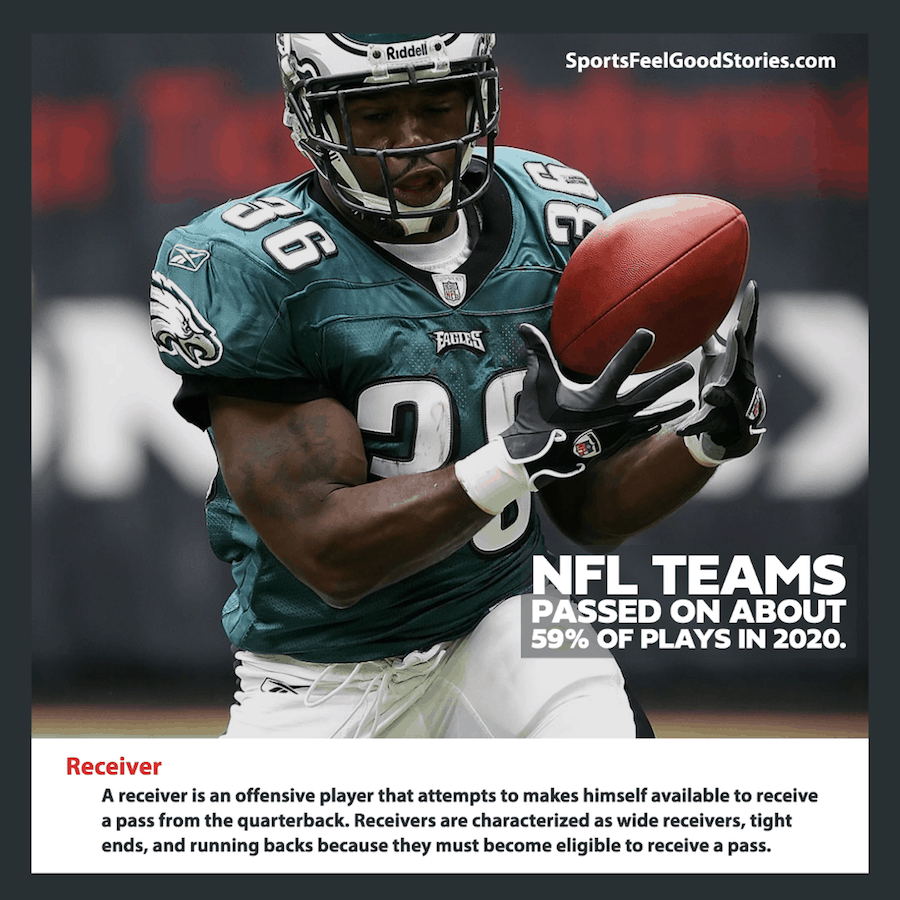The definition of the receiver in football continues to evolve in football. As both the college and NFL have become more passing leagues, receivers play bigger roles.
Dynamic athleticism, speed, and slick moves are some of the traits of the best receivers in football. Running routes and catching balls is one thing on the practice field and a totally different experience when facing a defense. The wide receiver role in football is a challenging one with a high profile. Let’s take a look at what being a receiver means.
What is a receiver in football?
The definition of a receiver in football is an offensive player that attempts to make himself available to receive a pass from the quarterback. Receivers typically are assigned these positions: wide receivers, tight ends, and running backs. Other positions must become eligible to receive a pass.
Key Takeaways
- Wide receivers, tight ends, and running backs are always eligible receivers.
- Offensive linemen cannot catch passes unless they line up on the outside of the line as tight ends.
- Once catching the ball, receivers can run the ball until the officials blow the play dead once the player has been tackled or has given himself up/run out of bounds.
- The role of receivers varies from play to play. Frequent roles including route running, blocking, and acting as a decoy.

How many receivers can be on the field?
To keep a more fair playing field, there can be no more than five of the 11 players on the offensive team eligible to receive a pass in the NFL. Seven players must line up at the line of scrimmage.
Two of the players lined up at either end of the line of scrimmage are eligible to receive a pass. If an ineligible player catches the ball, the player will be penalized for ‘illegal touching,’ and his team will lose a down and five yards from the original line of scrimmage.
What numbers do receivers wear?
Eligible receivers are required to wear certain jersey numbers. Running backs wear numbers 20-49, tight ends wear numbers 40-49 and 80-89, and wide receivers wear numbers 10-19 and 80-89. The only exception to this rule is if a player informs a referee that they intend to catch a forward pass.
What are the roles of receivers?
Receivers can take up different roles.
Wide receivers usually go straight into their route in an attempt to get open for a pass. Wide receivers are very dynamic because they can be the option for the big “home run” play or the short screen.
Tight ends help out with blocking and opening up to receive passes. Considering the tight end is usually of bigger stature, they often get small or mid-range passes and are typically better at breaking tackles.
Running backs do a little bit of everything. When running backs don’t get the ball off handoffs, they help out with blocking and running routes to receive passes. They usually catch short and mid-range passes.
Types of Receivers
Receivers are sometimes classified by coaches and analysts by the type of role they fulfill within the position. Here are the popular classifications.
What are possession receivers?
Possession receivers are receivers that teams rely on for shorter plays. As a result, they keep the chains moving. Possession receivers catch short screen passes and other short plays like quick slants and fade. When teams need a short gain, they rely on their possession receivers.
What are deep receivers?
Deep receivers are receivers that quarterbacks look for when looking for a big play. Deep receivers must be fast and be able to track the ball down. These players may only have a couple of catches a game, but they often are for bug chunks of yardage.
What are slot receivers?
Slot receivers are offensive players that line up behind the line of scrimmage and between the last offensive lineman on either side of the center and the receiver closest to that sideline. Slot receivers can be motioned to take a handoff or run a route to receive a pass. In one-on-one coverage, slot receivers are covered by slot corners.
Receivers in the NFL
As the peak of a football player’s career, the NFL is loaded with many great receivers. Travis Kelce has dominated the NFL at the tight end position with the Kansas City Chiefs in recent years. Kelce leads the NFL with 1,250 reception yards from 90 receptions after 13 games, also receiving nine touchdowns.
Second-year wide receiver DK Metcalf of the Seattle Seahawks has put up some stellar numbers since entering the NFL in 2019. Kamara led all wideouts with 1,180 reception yards from 69 receptions and ten touchdowns in the first 13 games of 2020.
Alvin Kamara is the most efficient running back receiver with the New Orleans Saints. From his first 13 games of 2020, Kamara led all running backs with 699 yards off of 77 receptions and four touchdowns.

Overtime
You’re on our Receiver Definition in Football page.
You might be interested in:
46 Defense: Strengths and Weaknesses
Football Terms and Definitions Dictionary
Drive Definition and Famous Scoring Drives
Football Fields Guide: Size With Diagram
